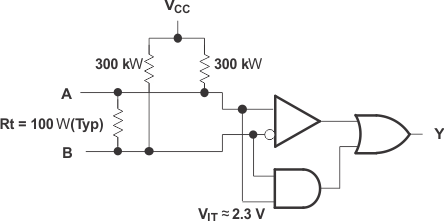SLLS373M July 1999 – March 2024 SN65LVDS1 , SN65LVDS2 , SN65LVDT2
PRODUCTION DATA
- 1
- 1 Features
- 2 Applications
- 3 Description
- 4 Device Options
- 5 Pin Configuration and Functions
- 6 Specifications
- 7 Parameter Measurement Information
- 8 Detailed Description
-
9 Application and Implementation
- 9.1 Application Information
- 9.2
Typical Applications
- 9.2.1
Point-to-Point Communications
- 9.2.1.1 Design Requirements
- 9.2.1.2
Detailed Design Procedure
- 9.2.1.2.1 Driver Supply Voltage
- 9.2.1.2.2 Driver Bypass Capacitance
- 9.2.1.2.3 Driver Input Voltage
- 9.2.1.2.4 Driver Output Voltage
- 9.2.1.2.5 Interconnecting Media
- 9.2.1.2.6 PCB Transmission Lines
- 9.2.1.2.7 Termination Resistor
- 9.2.1.2.8 Driver NC Pins
- 9.2.1.2.9 Receiver Supply Voltage
- 9.2.1.2.10 Receiver Bypass Capacitance
- 9.2.1.2.11 Receiver Input Common-Mode Range
- 9.2.1.2.12 Receiver Input Signal
- 9.2.1.2.13 Receiver Output Signal
- 9.2.1.2.14 Receiver NC Pins
- 9.2.2 Application Curve
- 9.2.3 Multidrop Communications
- 9.2.1
Point-to-Point Communications
- 10Power Supply Recommendations
- 11Layout
- 12Device and Documentation Support
- 13Revision History
- 14Mechanical, Packaging, and Orderable Information
8.3.2.1 Receiver Open Circuit Fail-Safe
One of the most common problems with differential signaling applications is how the system responds when no differential voltage is present on the signal pair. The LVDS receiver is like most differential line receivers in that its output logic state can be indeterminate when the differential input voltage is between –100 mV and 100 mV and within its recommended input common-mode voltage range. However, the TI LVDS receiver is different in how it handles the open-input circuit situation.
Open circuit means that there is little or no input current to the receiver from the data line itself. This could be when the driver is in a high-impedance state or the cable is disconnected. When this occurs, the LVDS receiver pulls each line of the signal to VCC through 300-kΩ resistors as shown in Figure 8-2. The fail-safe feature uses an AND gate with input voltage thresholds at about 2.3 V to detect this condition and force the output to a high level.
 Figure 8-2 Open-Circuit Fail-Safe of the LVDS Receiver
Figure 8-2 Open-Circuit Fail-Safe of the LVDS ReceiverIt is only under these conditions that the output of the receiver is valid with less than a 100-mV differential input voltage magnitude. The presence of the termination resistor, Rt does not affect the fail-safe function as long as it is connected as shown in Figure 8-2. Other termination circuits may allow a dc-current to ground that could defeat the pullup currents from the receiver and the fail-safe feature.